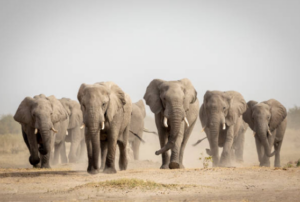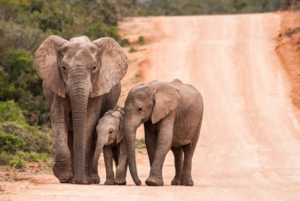Protecting Elephants

In the heart of the African and Asian landscapes, majestic elephants roam, embodying grace, intelligence, and a deep connection with the natural world. Unfortunately, these awe-inspiring creatures face an escalating threat—poaching for their ivory tusks. In this comprehensive beauty blog, we delve into the current state of elephant conservation, focusing on updates regarding anti-poaching efforts and the global initiatives to ban ivory trade. Join us on this journey as we explore the vital strides being made to protect elephants and ensure a future where these gentle giants thrive.
The Plight of Elephants: A Call to Action
Elephants, those grand architects of ecosystems, have become victims of human greed due to the demand for their ivory tusks. The ivory trade is a dark force that has fueled a crisis endangering these gentle giants. Their ivory, highly valued for its aesthetic appeal and perceived rarity, has turned elephants into lucrative targets for poachers. The consequences extend beyond the individual animals; it disrupts entire ecosystems, leaving a void that reverberates through the natural world.
- Impact on Elephant Populations
Poaching has led to a significant decline in elephant populations, particularly in Africa. The African elephant, one of the continent’s most iconic species, has seen a drastic reduction in numbers due to the insatiable demand for ivory. The illegal killing of elephants not only threatens their existence but also disrupts the delicate balance of ecosystems, affecting biodiversity and the well-being of surrounding flora and fauna.
- Disruption of Social Structures
Elephants, known for their complex social structures and familial bonds, suffer immeasurable trauma when a member of their herd is taken down by poachers. The repercussions extend to the entire herd, disrupting the intricate web of relationships that form the foundation of elephant society. The loss of a matriarch, for example, can have cascading effects on the survival and well-being of the entire group.
- Environmental Consequences
Beyond the immediate impact on elephant populations, poaching disrupts the ecological functions that elephants play in their habitats. As natural architects, elephants shape landscapes by creating water holes, clearing paths through dense vegetation, and dispersing seeds. The loss of elephants hinders these vital processes, affecting the health of ecosystems and the countless species that depend on them.

Anti-Poaching Efforts: A Beacon of Hope
Technological Advancements in Wildlife Protection
One of the most promising developments in anti-poaching efforts is the integration of cutting-edge technology. Drones equipped with thermal imaging cameras, GPS collars, and satellite tracking systems are being deployed to monitor elephant populations and detect potential poaching activities. These technological advancements provide real-time data, enabling rapid response teams to intervene and protect elephants from harm.
Community-Based Conservation Initiatives
Empowering local communities to actively participate in elephant conservation is a crucial aspect of anti-poaching efforts. Collaborative projects, such as community-based conservancies and wildlife sanctuaries, engage local residents in the protection and sustainable management of elephant habitats. By involving communities in conservation efforts, there is a higher likelihood of success in safeguarding these magnificent creatures.
Strengthening Legal Frameworks
Many countries have recognized the urgency of addressing poaching and have implemented stricter legal measures against the illegal ivory trade. Enhancing penalties for poaching, trafficking, and possession of ivory serves as a deterrent, sending a clear message that the world is committed to protecting elephants. Global cooperation is key to closing legal loopholes and ensuring consistent enforcement across borders.
Global Ivory Trade Bans: Progress and Challenges
The International Ban on Ivory Trade
The international community has made significant strides in recognizing the urgency of protecting elephants by implementing bans on the ivory trade. The Convention on International Trade in Endangered Species of Wild Fauna and Flora (CITES) has played a crucial role in establishing a global framework to regulate and restrict the trade in ivory. Under CITES, the international commercial trade in African elephant ivory has been banned since 1989, marking a pivotal moment in the fight against the exploitation of elephants for their tusks.
- The 1989 CITES Ban
The decision to implement the CITES ban in 1989 was a response to the alarming decline in elephant populations across Africa. Rampant poaching, fueled by demand for ivory products, had led to a devastating loss of elephants and threatened the species with extinction. The ban aimed to curb this crisis by eliminating the legal trade in elephant ivory, signaling a collective commitment to conservation efforts.
- Ivory Markets Closure Resolution
In 2016, recognizing the need for comprehensive action, CITES adopted a resolution calling for the closure of domestic ivory markets. This resolution acknowledged that legal domestic markets could serve as conduits for illegal ivory, perpetuating demand and providing cover for illicit activities. The closure of these markets became a crucial component of global efforts to combat the illegal ivory trade.
National Ivory Trade Bans: Success Stories
Several countries have taken bold steps to address the domestic ivory trade within their borders. These national bans complement the international efforts spearheaded by CITES and contribute to the overarching goal of protecting elephants from the devastating effects of poaching.
- China’s Landmark Ban
China, historically one of the largest markets for ivory, implemented a groundbreaking ban on ivory sales in 2017. This monumental decision marked a significant turning point in global conservation efforts. By closing down its legal ivory market, China dealt a severe blow to the ivory trade, reducing demand and sending a clear message that the country was committed to protecting elephants.
- United States, United Kingdom, and France
Other nations, including the United States, the United Kingdom, and France, have also implemented comprehensive bans on domestic ivory trade. These bans not only align with international efforts but also set high standards for ethical conduct within their respective borders. The closure of legal markets helps eliminate opportunities for laundering illegal ivory and disrupts the supply chain that sustains poaching activities.
Addressing Challenges and Loopholes
While progress has been made, challenges persist in fully eradicating the ivory trade. The clandestine nature of illegal markets and the adaptability of criminal networks pose significant obstacles to effective enforcement. Moreover, some countries continue to grapple with the implementation and enforcement of legislation due to various factors, including political instability, corruption, and economic pressures.
- Smuggling Networks and Black Markets
Sophisticated smuggling networks operate across borders, exploiting weaknesses in enforcement and taking advantage of porous regulatory systems. These networks often use advanced technologies and tactics to evade detection, making it challenging for law enforcement agencies to dismantle them. Addressing these networks requires coordinated international efforts and intelligence-sharing to track and apprehend those involved in the illegal ivory trade.
- Political and Economic Pressures
In regions where elephants are native, political and economic pressures may hinder the effective implementation of ivory trade bans. Corruption within governmental bodies, coupled with economic dependence on the ivory trade, can create an environment where enforcement becomes compromised. Advocating for political stability, transparency, and alternative livelihoods for communities affected by ivory bans is essential to overcoming these challenges.

Beauty Brands Taking a Stand
Commitment to Elephant-Friendly Products
An increasing number of beauty brands are aligning their values with conservation efforts by adopting elephant-friendly policies. These brands actively avoid the use of ivory or any derivative materials sourced from elephants. Instead, they focus on cruelty-free and sustainable alternatives, contributing to a shift in industry standards and consumer expectations.
Supporting Conservation Initiatives
Several beauty brands are going beyond merely avoiding elephant-derived ingredients; they are actively supporting conservation initiatives. Collaborations with wildlife organizations, donations to anti-poaching efforts, and raising awareness through product campaigns are becoming integral parts of the beauty industry’s commitment to protecting elephants.
Consumer Empowerment through Responsible Choices
Consumers play a pivotal role in driving change through their purchasing decisions. By choosing products from beauty brands committed to elephant conservation, consumers send a powerful message that ethical and sustainable practices are non-negotiable. Empowered consumers can drive market trends and influence the beauty industry to prioritize environmental and wildlife conservation.
Success Stories in Elephant Conservation
Amboseli Elephant Research Project, Kenya
The Amboseli Elephant Research Project in Kenya stands as a testament to the positive impact of long-term research on elephant behavior, social structures, and conservation. By understanding the needs and dynamics of elephant populations, researchers and conservationists can develop targeted strategies to protect these creatures and their habitats.
Elephant Nature Park, Thailand
The Elephant Nature Park in Thailand serves as a sanctuary and rehabilitation center for elephants rescued from abusive conditions. This initiative not only rescues elephants but also educates visitors about the importance of ethical treatment and conservation. Tourism with a focus on responsible and ethical interactions can contribute to the well-being of elephants.
David Sheldrick Wildlife Trust, Kenya
The David Sheldrick Wildlife Trust operates one of the most successful elephant orphanage and rehabilitation programs in Kenya. By rescuing and raising orphaned elephants, the trust ensures their eventual reintegration into the wild. Their efforts extend beyond rescue to community engagement, anti-poaching initiatives, and habitat conservation.
Raising Global Awareness
Creating widespread awareness about the challenges faced by elephants and the critical importance of their conservation is paramount. Social media campaigns, documentaries, and educational programs can serve as powerful tools to inform the global community and garner support for anti-poaching efforts and ivory trade bans.
Strengthening International Cooperation
Collaboration among nations, conservation organizations, and the private sector is essential for the success of global initiatives. Sharing resources, expertise, and technology on an international scale can significantly enhance anti-poaching efforts and reinforce the effectiveness of ivory trade bans.
Sustainable Development and Community Engagement
Promoting sustainable development that harmonizes with conservation goals is crucial for long-term success. Engaging local communities in wildlife conservation efforts ensures that the benefits of protecting elephants extend beyond ecological preservation to include socio-economic stability and community well-being.
Continued Research and Innovation
Ongoing research into elephant behavior, ecological requirements, and the impacts of climate change is vital for informed conservation strategies. Innovations in technology, such as advanced monitoring systems and non-invasive research techniques, contribute to a deeper understanding of elephant populations and their ecosystems.

Sustainable Tourism Practices
Tourism, when conducted responsibly, can contribute to the conservation of elephants and their habitats. Implementing sustainable tourism practices that prioritize the well-being of elephants and their ecosystems ensures a positive impact on local communities and encourages conservation-oriented tourism.
In the face of immense challenges, there is hope for a future where elephants roam freely, their habitats protected, and the allure of ivory replaced by a commitment to coexist with these magnificent beings. The collective efforts of conservationists, governments, beauty brands, and consumers are steering the course toward a more sustainable and compassionate world.
As we embark on this journey to protect elephants, let us recognize the interconnectedness of all living beings and the responsibility we share in preserving the diversity and beauty of our planet. Together, we can be the guardians of the giants, ensuring a legacy where elephants continue to enchant future generations with their grace and wisdom.

